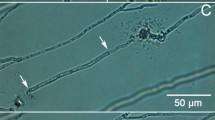Abstract
Growth parameters of vegetative hyphae and isolated tip fragments of the mycelial fungus N. crassa were studied after complete substitution of an easily metabolized carbon source (glucose) for a non-metabolized one (sorbitol). The images of growing tips were recorded at 20–30-min intervals. Using original image processing software, geometrical parameters of the hyphal trees (length and number of branches, area of convex polygons circumscribed about the hyphal trees, etc.) were determined and growth characteristics, such as rate of tip elongation (V) and the ratio of the total hyphal length to the number of growing tips (termed “hyphal growth unit”, HGU), were calculated. It is shown that after 4–5-h growth in sorbitol-enriched media growth characteristics of intact hyphae did not differ significantly from the corresponding parameters of hyphae growing in glucose-enriched media. In isolated tip fragments (about 800-μ m long), the values of V were lower than those in intact hyphae but did not depend on the carbon source in the nutrient media. However, in such fragments growing in sorbitol-enriched media the number of branches decreased, while the HGU value and the number of large intracellular vacuoles increased. Staining of cells with a standard chitin probe, Calcofluor White (10 μg/ml), did not reveal any considerable differences in hyphal cell walls and septa in tip fragments grown in the presence of different carbon sources. Possible mechanisms of the dependence of the tip growth parameters on the glucose deficiency are discussed.
Similar content being viewed by others
References
Trinci, A.P.J., Wiebe, M.G., and Robson, G.D., The Mycelium As an Integrated Entity, The Mycota. I. Growth, Differentiation, and Sexuality, Wessels, J.G.H. and Meinhart, F., Eds., Berlin-Heidelberg: Springer-Verlag, 1994, pp. 175–193.
Davis, R.H., Neurospora: Contributions of a Model Organism, Oxford: Oxford Univ. Press, 2000.
Borkovich, K.A., Alex, L.A., Yarden, O., and Freitag, M., et al., Lessons from the Genome Sequence of Neurospora crassa: Tracing the Path from Genomic Blueprint to Multicellular Organism, Microbiol. Mol. Biol. Rev., 2004, vol. 68. no. 1, pp. 1–108.
Potapova, T.V., Tip Growth of Neurospora crassa, Biologicheskie Membrany (Rus.), 2006, vol. 23, no. 6, pp. 436–452.
Trinci, A.P.J., A Study of the Kinetics of Hyphal Extension and Branch Initiation of Fungal Mycelia, J. Gen. Microbiol., 1974, vol. 81, pp. 225–236.
Aslanidi, K.B., Boitzova, L.Yu., Potapova, T.V., and Smolyaninov, V.V., The Unit of Hyphal Growth of Neurospora crassa As a Model of an Information and Energy Modulus, Biologicheskie Membrany (Rus.), 1996, vol. 13, no. 1, pp. 29–39.
Potapova, T.V., Intercellular Contacts in Neurospora crassa Hyphae: Twenty Years Later, Biologicheskie Membrany (Rus.), 2004, vol. 21, no. 3, pp. 163–191.
Reguelme, M., Reynaga-Pena, C.G., Gierz, G., and Bartnicki-Garcia, S., What Determines Growth Direction in Fungal Hyphae?, Fungal Genetic Biol., 1998, vol. 24, pp. 101–109
Aslanidi, K.B., Pogorelov, A.G., Aslanidi, O.V., Mornev, O.A., and Potapova, T.V., Potassium Distribution in the Neurospora crassa Hyphae, DAN (Rus.), 2000, vol. 372, no. 2, pp. 253–256.
Potapova, T.V., Aslanidi, K.B., Belozerskaya, T.A., and Levina, N.N., Transcellular Ionic Currents Studied by Intracellular Potential Recordings in Neurospora crassa Hyphae. Transfer of Energy from Proximal to Apical Cells, FEBS Lett., 1988, vol. 241, no. 12, pp. 173–176.
Aslanidi, K.B., Aslanidi, O.V., Vachadze, D.M., Mornev, O.A., Potapova, T.V., Chailakhyan, L.M., and Shtemantyan, E.G., A Mathematical Model of Electric Effects during Polarized Growth of N. crassa Hyphae, Biofizika (Rus.), 1997, vol. 42, no. 4, pp. 941–951.
Smolyaninov, V.V. and Potapova, T.V., Determination of the Critical Length of a Neurospora crassa Hyph Fragment, Biologicheskie Membrany (Rus.), 2003, vol. 20, no. 4, pp. 304–312.
Slayman, C.L., The Plasma Membrane ATPase of Neurospora: A Proton-Pumping Electroenzyme, J. Bioenerget. Biomem., 1987, vol. 19, pp. 1–20.
Robertson, N.F. and Rizvi, S.R.H., Some Observations on the Water Relations of the Hyphae of Neurospora crassa, Ann. Bot., 1968, vol. 32, pp. 279–291.
Slayman, C. and Potapova, T., Origin and Significance of Vacuolar Proliferation during Nutrient Restriction, Neurospora 2006 Poster Abstracts, http://www.fgsc.net/asil2006/2006posterabstracts.htm, no. 27.
Potapova, T.V. and Levina, N.N., Response of the Neurospora to Local Damage of the Cellular Membrane, Biologicheskie Membrany (Rus.), 1985, vol. 2, no. 12, pp. 1216–1218.
http://blade.nagaokaut.ac.jp/:_sinara/ruby/math/statistics2/index.html
Hickey, P.C., Swift, S.R., Roca, M.G., and Read, N.D., Live-Cell Imaging of Filamentous Fungi Using Vital Fluorescent Dyes and Confocal Microscopy, Meth. Microbiol., 2005, vol. 34, pp. 63–87.
Xie, X., Wilkinson, H.H., Correa, A., Lewis, Z.A., Bell-Pedersen, D., and Ebbole, D.J., Transcriptional Response to Glucose Starvation and Functional Analysis of a Glucose Transporter of Neurospora crassa, Fungal Genet. Biol., 2004, vol. 41, no. 12, pp. 1104–1119.
Slayman, C.L., Moussatos, V.V., and Webb, W.W., Endosomal Accumulation of pH Indicator Dyes Delivered As Acetoxymethyl Esters, J. Exp. Biol., 1994, vol. 196, pp. 419–438.
Potapova, T.V., Alexeevskii, T.A., Boitzova, L.Ju., and Slayman, C.L., Endogenous Energization of Growth in Neurospora, during Carbon Starvation, Abstracts of XV Congress of European Mycologists, St. Petersburg, Russia, September 16–21, 2007, p. 176.
Slaninova, I., Sestak, S., Svoboda, A., and Farkas, V., Cell Wall and Cytoskeleton Organization As the Response to Hyperosmotic Shock in Saccharomyces cerevisiae, J. Arch. Microbiol., 2000, vol. 173, no. 4, pp. 245–252.
Levina, N.N. and Lew, R.R., The Role of Tip-Localized Mitochondria in Hyphal Growth, Fungal Genet. Biol., 2006, vol. 43, no. 1, pp. 65–74.
Potapova, T.V., Alekseevskii, T.A., and Boitzova, L.Yu., Some Growth Peculiarities of Isolated Hyphal Tips of Neurospora crassa during Carbon Starvation, Dokl. Akad. Nauk (Rus.), 2008, vol. 421, no. 3, pp. 418–421.
Author information
Authors and Affiliations
Corresponding author
Additional information
Original Russian Text © T.V. Potapova, T.A. Alekseevskii, L.Yu. Boitzova, 2008, published in Biologicheskie Membrany, 2008, Vol. 25, No. 4, pp. 252–258.
Rights and permissions
About this article
Cite this article
Potapova, T.V., Alekseevskii, T.A. & Boitzova, L.Y. Tip growth of Neurospora crassa under glucose deprivation. Biochem. Moscow Suppl. Ser. A 2, 210–216 (2008). https://doi.org/10.1134/S1990747808030033
Received:
Published:
Issue Date:
DOI: https://doi.org/10.1134/S1990747808030033



